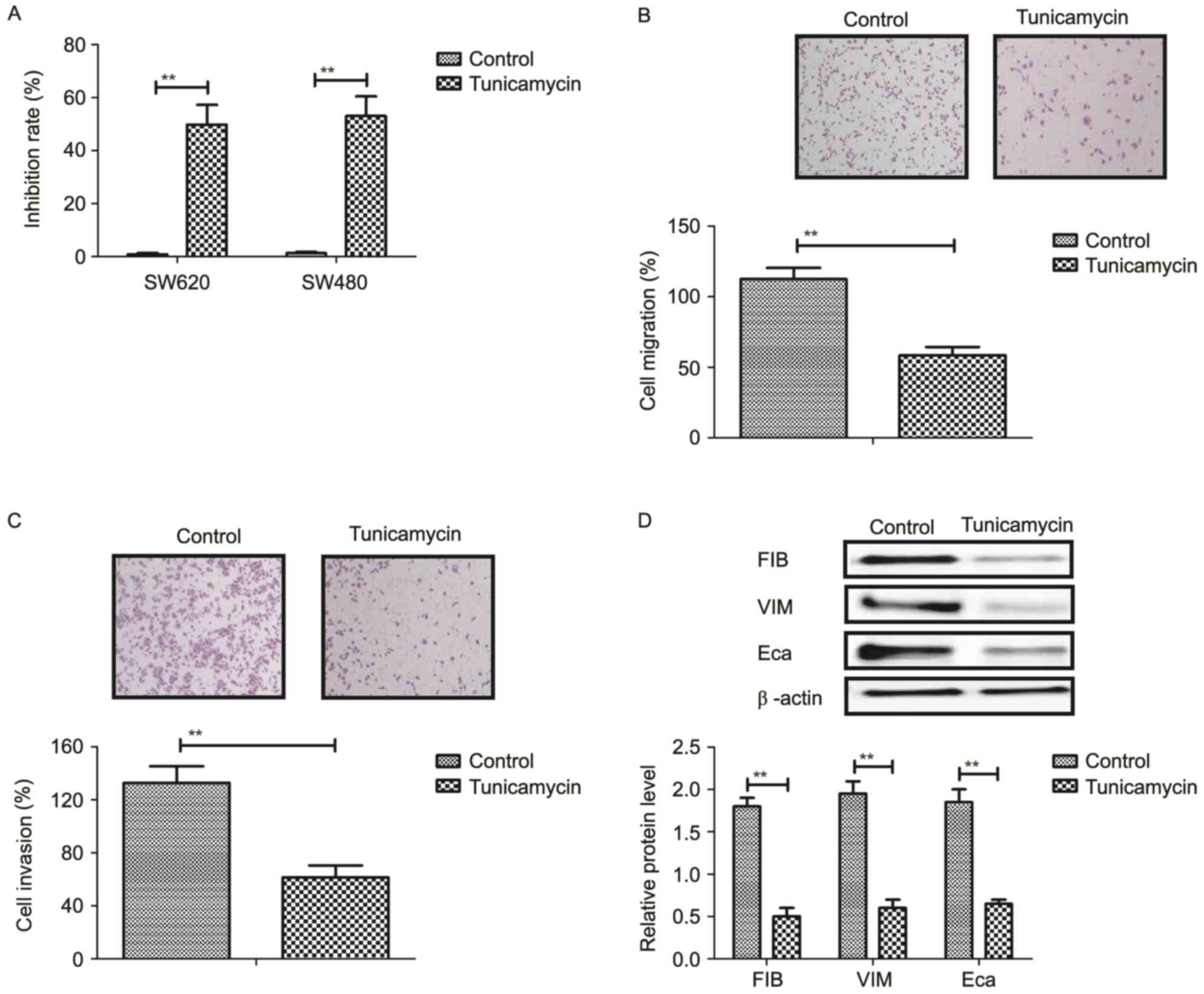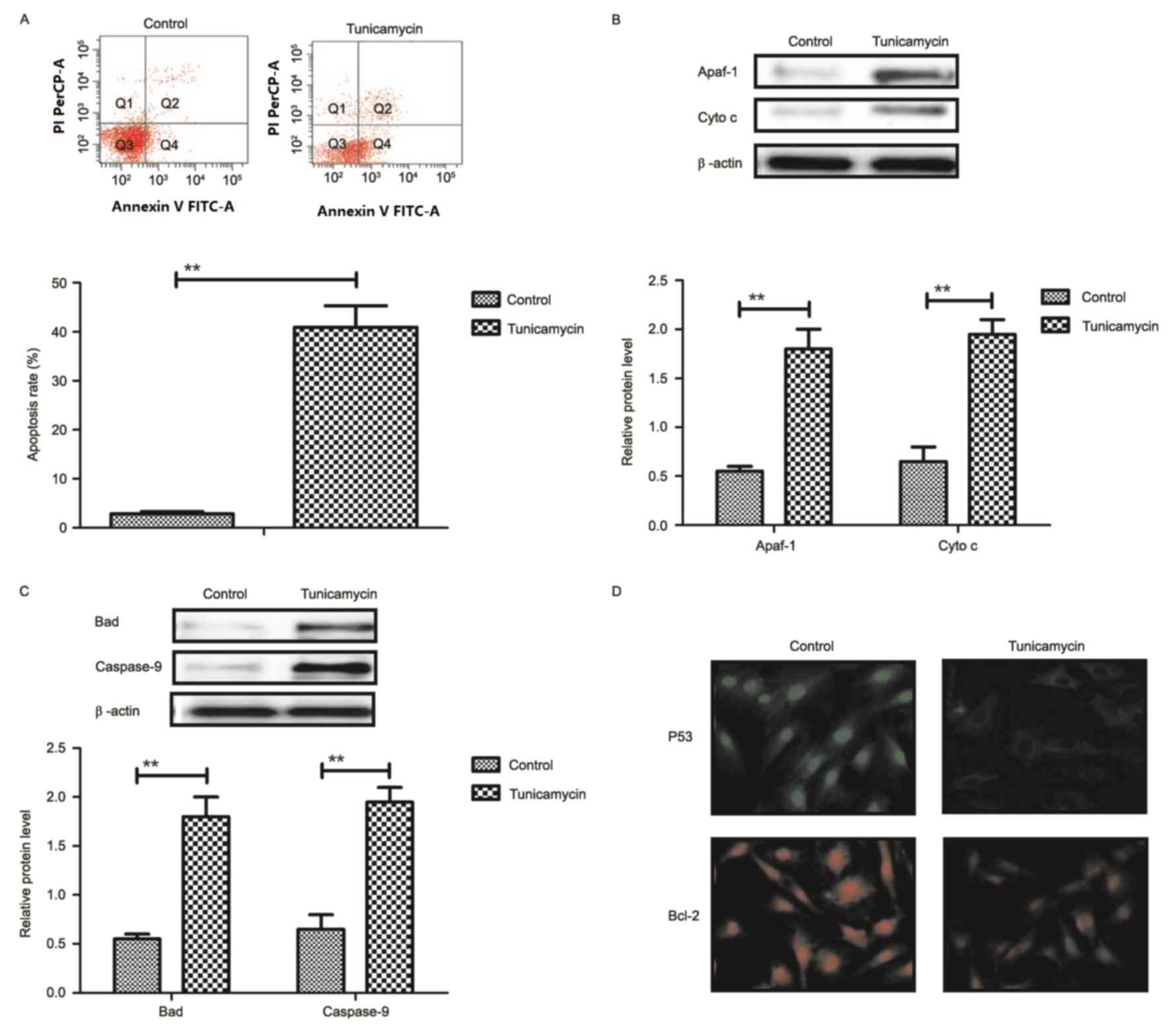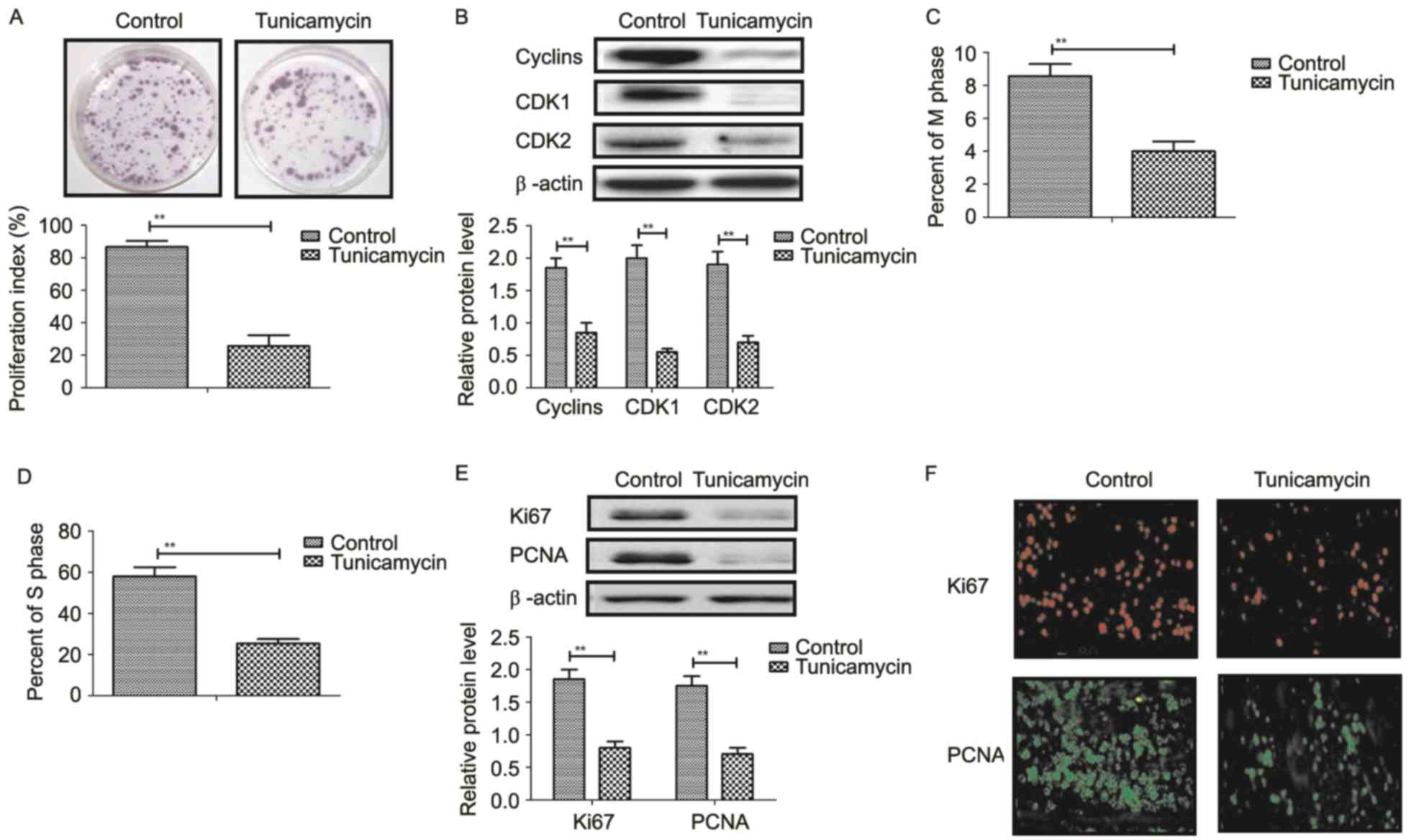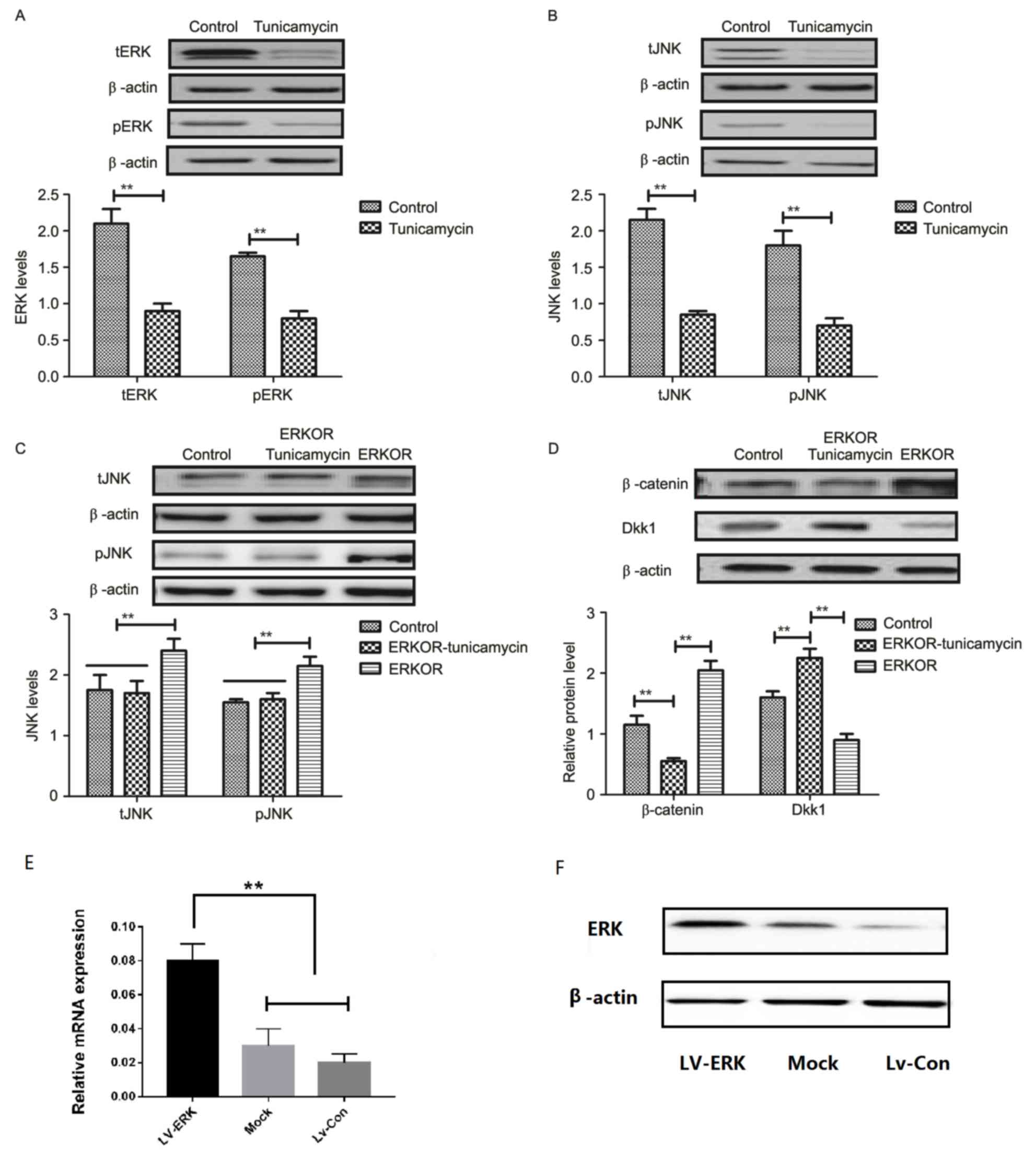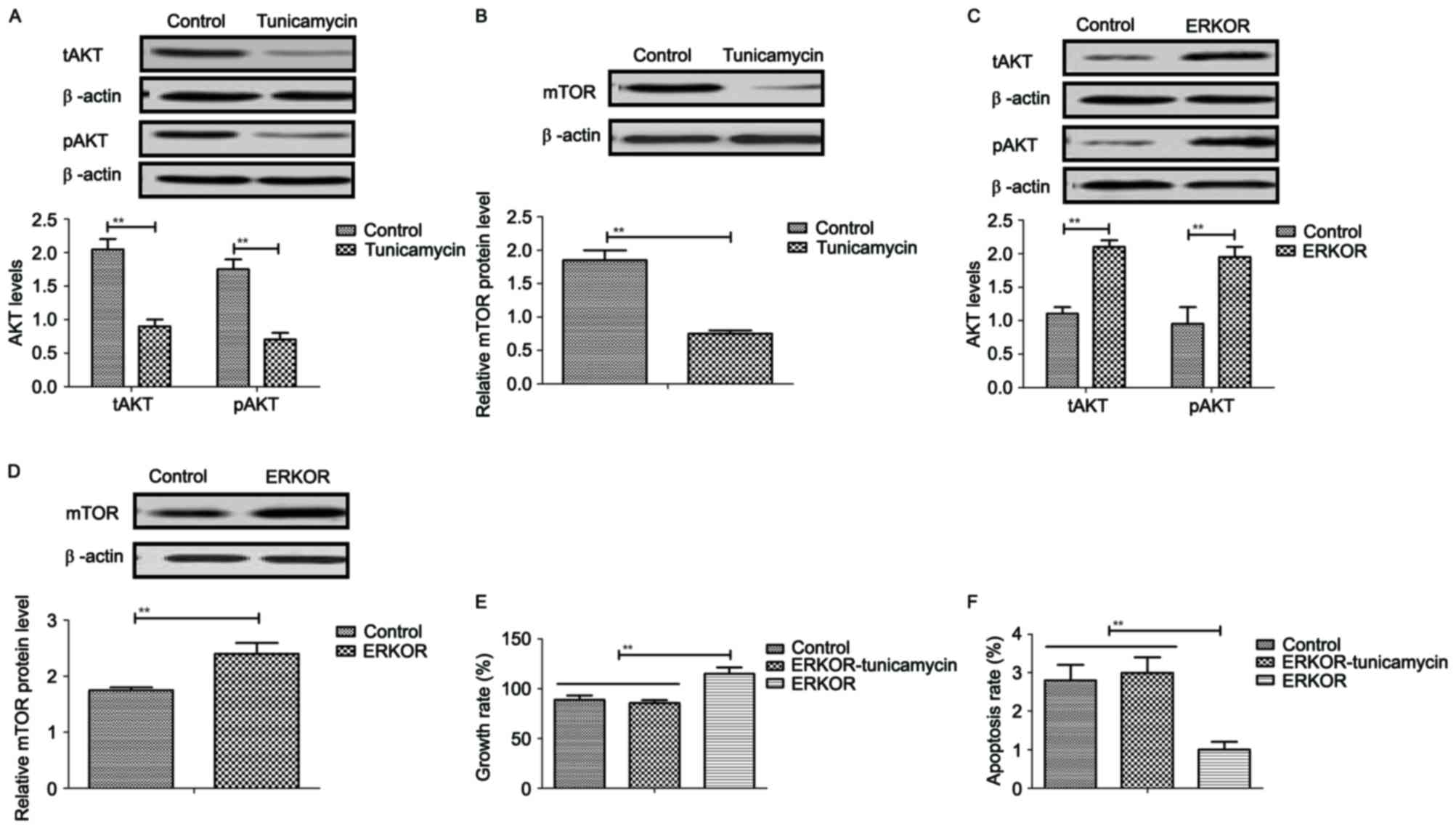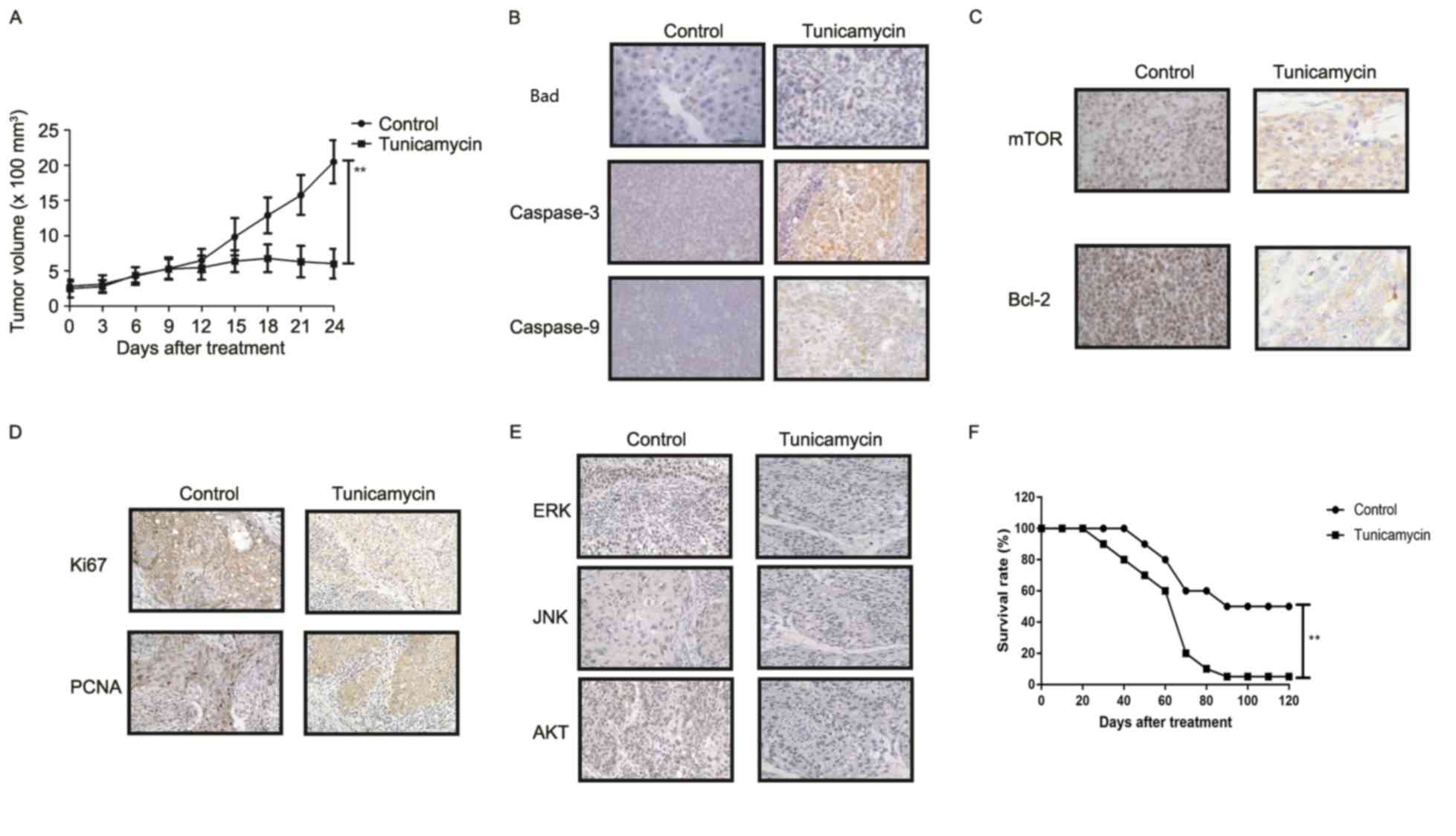Tunicamycin inhibits colon carcinoma growth and aggressiveness via modulation of the ERK-JNK-mediated AKT/mTOR signaling pathway
Retraction in: /10.3892/mmr.2024.13184
- Authors:
- Published online on: January 17, 2018 https://doi.org/10.3892/mmr.2018.8444
- Pages: 4203-4212
-
Copyright: © You et al. This is an open access article distributed under the terms of Creative Commons Attribution License.
Abstract
Introduction
Colon cancer is one of the most common digestive tract tumors, and is the second most common cancer in women and third most common cancer in men, worldwide (1). Rapid progression of colon cancer, and the way in which it metastasizes to local tissues and distant organs has been systematically reviewed and analyzed in a number of reports (2,3). In addition, previous reports have proposed available treatment modalities for colon cancer and have evaluated the accuracy of mini-probe endoscopic ultrasound in assigning clinical stages to colon cancer (4–6). However, appropriate management of diagnosis, treatments and prognosis of colorectal cancer has not been improved and is not clearly understood (5,6). Metastasis and invasion of colon cancer cells causes problems for clinicians attempting to treat the disease and worsens the disease in patients (7,8). Inhibition of colon cancer cell growth and metastasis prolongs survival of patients with colon cancer (9). Therefore, the underlying potential mechanisms of colon cancer cell growth, metastasis and invasion have been explored in target therapy for human cancer (10,11).
Tunicamycin is a nucleoside antibiotic (12,13). It is regarded as an inhibitor of glycosylation that disrupts the protein folding machinery in eukaryotic cells, which causes accumulation of unfolded proteins in the endoplasmic reticulum (14). Tunicamycin has been reported to exhibit anti-cancer potential in the published literature. A report demonstrated that tunicamycin inhibits growth and promotes apoptosis of human prostate cancer cells via glucose regulated protein 78-mediated apoptosis (15). Shiraishi et al (16) suggested that tunicamycin may enhance tumor necrosis factor-related apoptosis-inducing ligand (TRAIL)-induced apoptosis in human prostate cancer cells. Ling et al (17) revealed that tunicamycin may activate endoplasmic reticulum stress and inhibit epidermal growth factor receptor N-glycosylation in human non-small cell lung cancer cells. Additionally, research suggested that inhibition of N-linked glycosylation by tunicamycin may suppress E-cadherin-mediated proliferation, migration and invasion in human colon cancer cells (18).
In the present study, the inhibitory effects of tunicamycin in colon cancer cells, and the potential underlying mechanism, was investigated. As controlling tumor cell growth and metastasis is imperative for the survival of patients with colon cancer, molecular bioinformatics has enabled scientists to screen for targeted molecules that offer individual tailored therapies for patients with cancer or other human diseases (19,20). Therefore, the present study analyzed the anti-cancer efficacy of tunicamycin in colon cancer cells in vitro, and in xenograft mice. Results suggested that tunicamycin significantly inhibits growth and aggressiveness of colon cancer cells via downregulation of the extracellular signal-regulated kinase (ERK)/c-JUN N-terminal kinase (JNK)-mediated AKT/mammalian target of rapamycin (mTOR) signaling pathway. This research may provide molecular targets for colon cancer treatment.
Materials and methods
Ethics statement
The present study was performed in strict accordance with the recommendations in the Guide for the Care and Use of Laboratory Animals (21). All experimental protocols and animal procedures were approved by the Committee on the Ethics of Animal Experiments Defense Research of Jingmen No. 2 People's Hospital (Jingmen, China) Surgery and euthanasia were performed to minimize suffering.
Cells and reagents
Colon tumor cell lines SW620 and SW480 were purchased from American Type Culture Collection (Manassas, VA, USA). All tumor cells were cultured in Eagle's Minimum Essential medium (MEM; Sigma-Aldrich; Merck KGaA, Darmstadt, Germany) supplemented with 10% fetal calf serum (Invitrogen; Thermo Fisher Scientific, Inc., Waltham, MA, USA). All cells were cultured at 37°C and 5% CO2.
MTT assay
SW620 cells (1×105 cells/well) were incubated at room temperature with tunicamycin (0–2.5 mg/ml) in 96-well plates for 24, 48, 72 and 96 h in triplicate for each condition or with PBS as a control. After the indicated time incubation, 20 µl MTT (5 mg/ml) in PBS was added to each well for 4 h. Most of the medium was removed and 100 µl dimethyl sulfoxide was added into the wells to solubilize the crystals. The optical density was measured using a plate reader at a wavelength of 450 nm.
Tumor cell colony formation assay
SW620 cells (1×104) were plated in 6-well plates. Tunicamycin (2 mg/ml) was added to plates, or PBS was added as a control, and then cultured at 37°C. After 72 h culture, SW620 cells colonies were stained with crystal violet (0.005%) for 30 min and images were captured with a CX31 light microscope (Olympus Corporation, Tokyo, Japan). Clonal numbers of SW620 cells were analyzed by Alpha Innotech Corporation imaging software (version 3.30; San Leandro, CA, USA).
Cell invasion and migration assays
SW620 cells (1×105 cells/well) were incubated with tunicamycin (2 mg/ml) for 48 h. For invasion assay, SW620 cells were suspended at a density of 5×105 in 500 µl serum-free MEM. SW620 cells were transferred to the tops of BD BioCoat Matrigel invasion chambers (BD Biosciences, Franklin Lakes, NJ, USA) according to the manufacturer's protocol. For migration assay, cells were subjected to a control insert (BD Biosciences) instead of a Matrigel invasion chamber, 6 h at 37°C. Chambers were then incubated for 24 h at room temperature. Subsequently, cells were fixed with ice-cold methanol for 5 min then washed twice with PBS, the membrane was stained with crystal violet (1%) for 5 min at room temperature. Top chambers were cleaned with a cotton swab and the lower chamber was photographed under a light microscope (CX31 Olympus Corporation; magnification, ×200). Images of cells adhered to the lower surface of the chamber were captured (five random fields). Each experiment was performed in triplicate.
Endogenous overexpression of ERK
SW620 cells were cultured until 85% confluent and the culture media was then removed. Human ERK cDNA plasmids (Invitrogen; Thermo Fisher Scientific, Inc.) were transfected into 293T cells for 48 h to generate a lentivirus using Lipofectamine® 2000 (Sigma-Aldrich; Merck KGaA), according to the manufacturer's protocol. The viral supernatant was subsequently collected and used to infect the SW620 cells. Further analysis was performed 72 h post-transfection. Control groups included the mock treatment group and vector-transfected group. Reverse transcription-quantitative polymerase chain reaction (RT-qPCR) and western blotting were performed in order to determine the efficiency of transfection (21). Total RNA was extracted from SW620 cells (1×105 cells/well) with TRIzol reagent (Abcam, Cambridge, UK) according to the manufacturer's protocol. Total RNA (5 µg) was reverse transcribed into cDNA using an oligo-(dT) primer and M-MLV reverse transcriptase (Invitrogen; Thermo Fisher Scientific, Inc.) for qPCR analysis. qPCR was performed in a final volume of 10 µl, which consisted of 5 µl SsoFast™ EvaGreen Supermix (Bio-Rad Laboratories, Inc., Hercules, CA, USA), 1 µl cDNA (1:50 dilution) and 2 µl each of the forward and reverse primers (1 mM). The specific primers (Invitrogen; Thermo Fisher Scientific, Inc.) were as follows: ERK sense, 5′-CAAAGGTGGATCAGATTCAAG-3′ and antisense, 5′-GGTGAGCATTATCACCCAGAA-3′; GAPDH sense, 5′-CAAAGGTGGATCAGATTCAAG-3′ and antisense, 5′-GGTGAGCATTATCACCCAGAA-3′. The thermal cycling procedure was as follows: 95°C for 4 min, followed by 40 cycles of 95°C for 25 sec, 55°C for 30 sec and 72°C for 20 sec with 2 sec for plate reading, and melting curve analysis from 65 to 95°C. GAPDH was used as the control for normalizing gene expression. The relative quantification of the gene of interest was determined using the comparative ΔCq method (22).
Xenograft tumor model
A total of 80 specific pathogen-free male Balb/c (6–8 weeks old) nude mice were purchased from Slack Life Co., Ltd. (Shanghai, China). All mice were housed at preference temperature (22–24°C) under a 12-h light-dark cycle and fed ad libitum at 40-70% humidity. SW620 cells (1×106) were mixed with 100 µl PBS and injected subcutaneously in the flanks of Balb/c mice (n = 60). Xenograft mice were divided into two groups of 40, the treatment group received treatment with tunicamycin (10 mg/kg) by one intravenous injection on day 6 after tumor implantation (diameter, 5–8 mm) and the control group received 100 µl PBS by intravenous injection. The tumor volumes were calculated according to a previous study (23). The tumor volumes were calculated according to the following formula: length × width2 × 0.52. On day 25, mice (n=20 in each group) were sacrificed under 1.5% pentobarbital sodium (1 ml/kg; Lianshuoinc, Shanghai, China) for further analysis. Residual mice (n=20 in each group) were continued to be housed in order to analyze the long-term survival rate (considered to be 120 days). In the survival rate experiments, the largest tumor size was ~2,000 mm3. Mice were sacrificed with 1.5% pentobarbital sodium (100 mg/kg) by intravenous injection when tumor diameter reached 12 mm. On day 25, mice (n=10 in each group) were sacrificed to make further analysis. The remaining mice (n=10 in each group) were continued to house to analyze the long-term survival rate (120 days). The remaining mice were sacrificed with 1.5% pentobarbital sodium (100 mg/kg) by intravenous injection at the end of the experiment.
Western blotting
Protein samples from colorectal tumors and SW620 cells were homogenized using radioimmunoprecipitation assay lysis buffer (Invitrogen; Thermo Fisher Scientific, Inc.) and were centrifuged at 7,103 × g at 4°C for 10 min. The protein concentrations of the cell extracts were then measured using Bradford protein dye reagent (Bio-Rad Laboratories, Inc.). A total of 30 µg/lane protein was loaded and separated by SDS-PAGE (12% gel) and transferred to nitrocellulose membranes. The membranes were blocked with 5% skimmed milk for 1 h at room temperature, washed in Tris-buffered saline containing 0.1% Tween-20 (TBST) and incubated with the following primary antibodies: Anti-FIB (1:2,000; ab4566; Abcam), anti-VIM (1:1,000; ab8978, Abcam), anti-Eca (1:1,000; ab11512; Abcam), anti-Bad (1:2,000; ab32445; Abcam), anti-Caspase9 (1:1,000; ab32539; Abcam), anti-Apaf-1 (1:2,000; ab2001; Abcam), anti-Cyto c (1:2,000; ab13575; Abcam), anti-Cyclin D1 (1:2,000; ab134175; Abcam), anti-CDK1 (1:2,000; ab133327; Abcam), anti-CDK2 (1:2,000; ab32147; Abcam), anti-Ki67 (1:1,000; ab16667; Abcam), anti-PCNA (1:1,000; ab18197; Abcam), anti-t-ERK (1:2,000; ab196883; Abcam), anti-p-ERK (1:2,000; ab214362; Abcam), anti-t-JNK (1:1,000; ab179461; Abcam), anti-p-JNK (1:1,000; ab76572; Abcam), anti-β-catenin (1:1,000; ab16051; Abcam), anti-Dkk1 (1:1,000; ab109416; Abcam), anti-t-AKT (1:1,000; ab8978; Abcam), anti-p-AKT (1:1,000; ab8933; Abcam), anti-mTOR (1:1,000; ab87540; Abcam), and anti-β-actin (1:5,000; ab8226; Abcam) overnight at 4°C. The labeled membranes were then washed three times with TBST, incubated for 2 h at room temperature with secondary anti-mouse primary IgG (1:1,500; ab6785; Abcam) and anti-rabbit primary IgG (1:1,500; ab6721; Abcam) conjugated with horseradish peroxidase. The protein bands labeled with the antibodies were visualized using the SuperSignal West Pico Chemiluminescent Substrate Trial Kit (Pierce; Thermo Fisher Scientific, Inc.). Images were obtained using the ChemiDoc XRS system with Quantity One software (Bio-Rad Laboratories, Inc.). Protein expression was analyzed using BandScan software (version 5.0; Glyko, Inc., Novato, CA, USA). All experiments were repeated ≥3 times.
Immunohistochemistry
Colon tumors from xenograft mice were fixed using formaldehyde (10%) at room temperature for 24 h and were then embedded in paraffin. The tissues were cut into 4-µm sections and mounted on glass slides. The sections were rinsed with PBS and placed in a solution containing primary antibodies directed against Ki67 (1:1,000; ab16667; Abcam), PCNA (1:1,000; ab18197; Abcam), Caspase3 (1:2,000; ab90437; Abcam), Caspase9 (1:1,000; ab32539; Abcam), Bcl-2 (1:1,000; ab692; Abcam), ERK (1:2,000; ab196883; Abcam), JNK (1:1,000; ab179461; Abcam), mTOR (1:1,000; ab87540; Abcam) and AKT (1:1,000; ab8978; Abcam) incubated overnight at 4°C. Subsequently, sections were incubated with the appropriate secondary antibodies, mouse primary IgG (1:1,500; ab6785; Abcam) and rabbit primary IgG (1:1,500; ab6721; Abcam), for 2 h at room temperature were added to specimens prior to visualization. The sections were then washed with PBS and observed by fluorescent video microscopy (BZ-9000; Keyence Corporation, Osaka, Japan) and a Ventana BenchMark automated staining system (Roche Applied Science, Penzberg, Germany) was used for observation of protein expression levels. A negative control was employed wherein mice were injected with 100 µl PBS.
Apoptosis assay
SW620 cells were cultured at 37°C and 5% CO2 until 90% confluent. Apoptosis was assessed by incubating the cells with tunicamycin (2.0 mg/ml) for 48 h. After incubation, SW620 cells were trypsinized and collected. The cells were then washed in cold PBS, resuspended to 1×106 cells/ml in PBS, labeled with Annexin V-fluorescein isothiocyanate (FITC) and propidium iodide using an Annexin V-FITC kit from BD Biosciences, and analyzed on a FACScan flow cytometer (BD Biosciences) using Cell Quest acquisition software (version 2.9; BD Biosciences). The treatments were performed in triplicate, and the percentage of labeled cells undergoing apoptosis in each group was determined and calculated using Cell Quest acquisition software.
Cell cycle analysis
Prior to testing, SW620 cells were treated with tunicamycin and PBS for 48 h, as aforementioned. Following this, 1×105 cells were collected and fixed with ice-cold ethanol (70%; 10 min on ice) prior to washing, re-suspension in cold PBS and incubation at 37°C for 30 min with 10 mg/ml RNase and 1 mg/ml propidium iodide (Sigma-Aldrich; Merck KGaA). DNA content was analyzed by a FACScan Flow cytometer (BD Biosciences, San Jose, CA, USA). The percentage of cells in each phase of the cell cycle was determined using Cell Quest acquisition software (version 2.9; BD Biosciences).
Statistical analysis
Data are expressed as the mean ± standard deviation of triplicate experiments and analyzed by using a Student t test or one-way analysis of variance followed by the Tukey's honest significant difference post hoc test. All data were analyzed using SPSS software version 19.0 (IBM Corp., Armonk, NY, USA), GraphPad Prism version 5.0 software (GraphPad Software, Inc., La Jolla, CA, USA) and Microsoft Excel (Microsoft Corporation, Redmond, WA, USA). P<0.05 was considered to indicate a statistically significant difference.
Results
Tunicamycin treatment inhibits growth and aggressiveness of colon cancer cells
The inhibitory effects of tunicamycin on growth and aggressiveness of colon cancer cells were investigated. As demonstrated in Fig. 1A, tunicamycin significantly inhibited SW620 and SW480 cell growth (P<0.01). Migration and invasion assays demonstrated that tunicamycin treatment suppressed aggressiveness of SW620 cells (P<0.01; Fig. 1B and C). Western blotting demonstrated that fibronectin, vimentin and E-cadherin expression levels were decreased by tunicamycin treatment (P<0.01; Fig. 1D). These results suggested that tunicamycin treatment may inhibit growth and aggressiveness of colon cancer cells.
Tunicamycin treatment promotes apoptosis of colon cancer cells via the mitochondrial apoptotic signaling pathway
Results revealed that tunicamycin treatment promoted apoptosis of colon cancer cells (Fig. 2A). Western blotting demonstrated that expression levels of apoptotic peptidase activating factor-1 and cytochrome c were increased by tunicamycin treatment compared with control cells in SW620 cells (Fig. 2B). Bcl-2 associated agonist of cell death and caspase-9 expression levels were increased in SW620 cells treated with tunicamycin compared with control cells, as determined by western blotting (Fig. 2C). Immunofluorescence revealed that tumor protein p53 (P53) and B-cell lymphoma-2 (Bcl-2) expression levels were downregulated by tunicamycin treatment in SW620 cells, compared with the control (Fig. 2D). These results suggested that tunicamycin treatment may promote apoptosis of colon cancer cells via the mitochondrial apoptosis signaling pathway.
Tunicamycin treatment suppresses proliferation and arrests the cell cycle of colon cancer cells
Tunicamycin treatment suppressed proliferation of SW620 cells compared to control cells (Fig. 3A). Western blot revealed that tunicamycin treatment significantly inhibited the expression levels of cyclin D1, cyclin dependent kinase (CDK)1 and CDK2 in SW620 cells compared with the control (Fig. 3B). Cells cycle showed that tunicamycin treatment suppressed entry to M phase and S phase in SW620 cells (Fig. 3C and D). Western blotting and immunofluorescence revealed that tunicamycin administration decreased the expression levels of Ki67 and proliferating cell nuclear antigen (PCNA) in SW620 cells (Fig. 3E and F). These results suggested that tunicamycin treatment suppressed proliferation and arrested the cell cycle in colon cancer cells.
Tunicamycin treatment suppresses the ERK-JNK signaling pathway in colon cancer cells
To analyze the underlying molecular mechanism of growth and apoptosis, components of the ERK-JNK signaling pathway in colon cancer cells were investigated. Expression and phosphorylation of ERK and JNK were downregulated in tunicamycin-treated SW620 cells, compared with control cells (Fig. 4A and B). ERK overexpression (ERKOR) significantly promoted JNK expression and phosphorylation in SW620 cells, compared with control cells and the ERKOR Tunicamycin group. In addition, the ERKOR Tunicamycin group appeared to not promote JNK expression and phosphorylation in SW620 cells when compared with control cells (Fig. 4C). Results demonstrated that ERK overexpression promoted expression of beta-catenin, and downregulated Dickkopf-1 in SW620 cells, compared with the control and ERKOR Tunicamycin group. Also, ERKOR Tunicamycin group inhabited expression of β-catenin and upregulated Dickkopf-1 in SW620 cells, compared with the control and ERKOR group (Fig. 4D). As determined by RT-qPCR and western blotting, the cells in the LV-ERK group stably overexpressed ERK at both the mRNA and protein level, as compared with the mock treatment group or vector-transfected group (Fig. 4E and F). These results suggested that tunicamycin treatment may suppress ERK-JNK signaling pathway in colon cancer cells.
Tunicamycin treatment inhibits growth and promotes apoptosis of colon cancer cells via the ERK-JNK-mediated AKT/mTOR signaling pathway
The potential underlying mechanism of tunicamycin-mediated growth inhibition and apoptosis in colon cancer cells was investigated. Results revealed that tunicamycin treatment inhibited AKT expression and phosphorylation in SW620 cells, compared with the control (P<0.01; Fig. 5A). mTOR expression levels were also inhibited by tunicamycin in SW620 cells compared with the control (P<0.01; Fig. 5B). ERKOR increased AKT expression and phosphorylation in SW620 cells compared with control cells (Fig. 5C). Results demonstrated that ERK overexpression increased mTOR expression levels in SW620 cells compared with the control (Fig. 5D). Tunicamycin abolished ERK overexpression-induced growth and ERK overexpression-induced inhibition of apoptosis in SW620 cells (P<0.01; Fig. 5E and F). These results suggested that Tunicamycin treatment may inhibit growth and promote apoptosis of colon cancer cells via the ERK-JNK-mediated AKT/mTOR signaling pathway.
Tunicamycin treatment inhibits tumor growth and prolongs survival of colon-bearing mice
The anti-tumor effect of tunicamycin treatment was investigated in SW620-bearing nude mice. Tunicamycin treatment (10 mg/kg) significantly inhibited tumor growth in a 25-day observation compared with the control group (Fig. 6A). Immunohistochemistry revealed that tunicamycin treatment increased apoptosis (bad), caspase-3 and caspase-9 expression levels in tumor tissues compared with the PBS group (Fig. 6B). Tunicamycin treatment decreased the expression levels of mTOR and Bcl-2 in tumor tissues (Fig. 6C). Tunicamycin treatment decreased Ki67 and PCNA expression levels in tumor tissues (Fig. 6D). Immunohistochemistry demonstrated that tunicamycin treatment decreased ERK, JNK and AKT expression in tumor tissues (Fig. 6E). Tunicamycin treatment prolonged the survival of SW620-bearing mice in a 120-day experiment (P<0.01; Fig. 6F). These results suggested that tunicamycin exhibits inhibitory effects on tumor growth and prolongs survival of SW620-bearing mice.
Discussion
Colon cancer is a common malignant digestive tract tumor, and usually occurs at the junction between the rectum and sigmoid colon (24). Systematic review has demonstrated that peritoneal carcinomatosis from colon cancer blocks cytoreduction and intraperitoneal chemotherapy, which requires further investigation (25). Advanced stage colon carcinoma possesses an aggressive ability to attack adjacent and distant cells and/or organs (26,27). Diagnosis, treatments and prognosis of colon cancer has been improved, chemotherapies, radiation therapies and surgery for colon cancer have been developed clinically (28). However, appropriate management of treatments of colorectal cancer has not been improved and is not clearly understood due to local migration and long-distance metastasis (26). Tunicamycin may inhibit tumor growth and enhance apoptosis in human cancer cells (16,18). In this study, the inhibitory effects of tunicamycin treatment in colon cancer cells were investigated in vitro and in vivo. Tunicamycin-mediated apoptosis and growth inhibition and the potential underlying mechanism, were investigated. Results revealed that tunicamycin treatment inhibited growth, proliferation and aggressiveness, and promoted apoptosis of colon cancer cells. In vivo assays demonstrated that tunicamycin treatment significantly suppresses tumor growth and prolongs survival of tumor bearing mice, suggesting tunicamycin may be a potential anti-cancer agent for colon carcinoma therapy.
Induction of apoptosis and death of tumor cells to inhibit growth and aggressiveness in patients is the ultimate goal of neoplastic therapy. A study demonstrated that downregulation of nuclear factor-κB may induce apoptosis and cell cycle arrest in HCT116 human colon cancer cells (29). Wan et al (30) suggested that upregulation of the caspase-3-dependent pathway inhibits growth of human colon cancer cells and induced apoptosis. In addition, a report revealed that downregulation of the Bcl-2 associated X apoptosis regulator/Bcl-2 ratio and upregulation of caspase-9-dependent pathway may promote apoptosis of HT-29 human colon cancer cells (31). Furthermore, Travica et al (32) demonstrated that colon cancer-specific cytochrome P450 2W1 may convert duocarmycin analogues into potent tumor cytotoxins, which further induces apoptosis of HT29, DLD-1 and LoVo colon cancer cells (33). In the present study, the results revealed that tunicamycin induced apoptosis of colon cancer cells by downregulation of Bcl-2 and P53 expression levels. Results also suggested that caspase-3 and caspase-9 expression levels were upregulated by tunicamycin treatment, which markedly induced apoptosis of colon cancer cells in tumor-bearing mice.
Clinical treatments are required for the inhibition of migration and invasion, to prolong survival of patients with colon carcinoma (34,35). Reports have suggested that tunicamycin serves an important role in tumorigenesis, growth, proliferation, aggressiveness and apoptosis via regulation of the P38 mitogen-activated protein kinase signaling pathway (36,37). Research has suggested that upregulation of the ERK-JNK signaling pathway promotes metastasis of colon cancer cells via crosstalk between C-C motif chemokine ligand 7 and C-C motif chemokine receptor 3 (38). The findings of the present study suggested that tunicamycin treatment inhibits growth and metastasis of colon carcinoma cells by downregulation of ERK-JNK signaling pathways. Additionally, Tandutinib may inhibit the AKT/mTOR signaling pathway to suppress colon cancer growth in vitro and in vivo, which is consistent with previously published reports (39–41). It was also observed that tunicamycin treatment decreased Ki67 and PCNA expression levels in tumor tissues, which was associated with apoptosis and increased survival of tumor bearing mice (42).
In conclusion, the results of the current study suggested that tunicamycin treatment efficiently inhibits colon carcinoma cell growth and aggressiveness via downregulation of expression levels of vimentin, FIB and Ecacollagen type I and Slug. Tunicamycin treatment may promote apoptosis of colon carcinoma cells via the ERK-JNK-mediated AKT/mTOR signaling pathway, which further contributes to inhibition of tumor growth both in vitro and in vivo, and prolong survival of SW620-bearing mice. These findings suggested that tunicamycin may be a potential anti-cancer agent for treatment of colon carcinoma.
References
|
Siegel R, Desantis C and Jemal A: Colorectal cancer statistics, 2014. CA Cancer J Clin. 64:104–117. 2014. View Article : Google Scholar : PubMed/NCBI | |
|
Hirai HW, Tsoi KK, Chan JY, Wong SH, Ching JY, Wong MC, Wu JC, Chan FK, Sung JJ and Ng SC: Systematic review with meta-analysis: Faecal occult blood tests show lower colorectal cancer detection rates in the proximal colon in colonoscopy-verified diagnostic studies. Aliment Pharmacol Ther. 43:755–764. 2016. View Article : Google Scholar : PubMed/NCBI | |
|
Fahrner R, Theis B, Ardelt M, Rauchfuss F, Schüle S and Settmacher U: Rapid progressive colon cancer metastasized to the right epididymis and liver: Report of a case and review of the literature. Int J Colorectal Dis. 31:721–722. 2016. View Article : Google Scholar : PubMed/NCBI | |
|
Gall TM, Markar SR, Jackson D, Haji A and Faiz O: Mini-probe ultrasonography for the staging of colon cancer: A systematic review and meta-analysis. Colorectal Dis. 16:O1–O8. 2014. View Article : Google Scholar : PubMed/NCBI | |
|
Kim HD, Ha KS, Woo IS, Jung YH, Han CW and Kim TJ: Tumor lysis syndrome in a patient with metastatic colon cancer after treatment with 5-fluorouracil/leucovorin and oxaliplatin: Case report and literature review. Cancer Res Treat. 46:204–207. 2014. View Article : Google Scholar : PubMed/NCBI | |
|
Petrelli F, Tomasello G, Borgonovo K, Ghidini M, Turati L, Dallera P, Passalacqua R, Sgroi G and Barni S: Prognostic survival associated with left-sided vs right-sided colon cancer: A systematic review and meta-analysis. JAMA Oncol. Oct 27–2016.(Epub ahead of print). | |
|
Moilanen JM, Kokkonen N, Löffek S, Väyrynen JP, Syväniemi E, Hurskainen T, Mäkinen M, Klintrup K, Mäkelä J, Sormunen R, et al: Collagen XVII expression correlates with the invasion and metastasis of colorectal cancer. Hum Pathol. 46:434–442. 2015. View Article : Google Scholar : PubMed/NCBI | |
|
Fan Z, Cui H, Xu X, Lin Z, Zhang X, Kang L, Han B, Meng J, Yan Z, Yan X and Jiao S: MiR-125a suppresses tumor growth, invasion and metastasis in cervical cancer by targeting STAT3. Oncotarget. 6:25266–25280. 2015. View Article : Google Scholar : PubMed/NCBI | |
|
Siani LM and Garulli G: Laparoscopic complete mesocolic excision with central vascular ligation in right colon cancer: A comprehensive review. World J Gastrointest Surg. 8:106–114. 2016. View Article : Google Scholar : PubMed/NCBI | |
|
Ma J, Ma P, Zhao C, Xue X, Han H, Liu C, Tao H, Xiu W, Cai J and Zhang M: B7-H3 as a promising target for cytotoxicity T cell in human cancer therapy. Oncotarget. 7:29480–29491. 2016.PubMed/NCBI | |
|
Hamamoto R and Nakamura Y: Dysregulation of protein methyltransferases in human cancer: An emerging target class for anticancer therapy. Cancer Sci. 107:377–384. 2016. View Article : Google Scholar : PubMed/NCBI | |
|
Matsui H, Ito H, Taniguchi Y, Takeda S and Takahashi R: Ammonium chloride and tunicamycin are novel toxins for dopaminergic neurons and induce Parkinson's disease-like phenotypes in medaka fish. J Neurochem. 115:1150–1160. 2010. View Article : Google Scholar : PubMed/NCBI | |
|
Reszka N, Krol E, Patel AH and Szewczyk B: Effect of tunicamycin on the biogenesis of hepatitis C virus glycoproteins. Acta Biochim Pol. 57:541–546. 2010.PubMed/NCBI | |
|
Nami B, Donmez H and Kocak N: Tunicamycin-induced endoplasmic reticulum stress reduces in vitro subpopulation and invasion of CD44+/CD24- phenotype breast cancer stem cells. Exp Toxicol Pathol. 68:419–426. 2016. View Article : Google Scholar : PubMed/NCBI | |
|
Miyake H, Hara I, Arakawa S and Kamidono S: Stress protein GRP78 prevents apoptosis induced by calcium ionophore, ionomycin, but not by glycosylation inhibitor, tunicamycin, in human prostate cancer cells. J Cell Biochem. 77:396–408. 2000. View Article : Google Scholar : PubMed/NCBI | |
|
Shiraishi T, Yoshida T, Nakata S, Horinaka M, Wakada M, Mizutani Y, Miki T and Sakai T: Tunicamycin enhances tumor necrosis factor-related apoptosis-inducing ligand-induced apoptosis in human prostate cancer cells. Cancer Res. 65:6364–6370. 2005. View Article : Google Scholar : PubMed/NCBI | |
|
Ling YH, Li T, Perez-Soler R and Haigentz M Jr: Activation of ER stress and inhibition of EGFR N-glycosylation by tunicamycin enhances susceptibility of human non-small cell lung cancer cells to erlotinib. Cancer Chemother Pharmacol. 64:539–548. 2009. View Article : Google Scholar : PubMed/NCBI | |
|
de Freitas Junior JC, Silva Bdu R, de Souza WF, de Araújo WM, Abdelhay ES and Morgado-Diaz JA: Inhibition of N-linked glycosylation by tunicamycin induces E-cadherin-mediated cell-cell adhesion and inhibits cell proliferation in undifferentiated human colon cancer cells. Cancer Chemother Pharmacol. 68:227–238. 2011. View Article : Google Scholar : PubMed/NCBI | |
|
BukurovaIu A, Khankin SL, Krasnov GS, Grigor'eva ES, Mashkova TD, Lisitsin NA, Karpov VL and Beresten' SF: Comparison of 2D analysis and bioinformatics search efficiency for colon cancer marker identification. Mol Biol (Mosk). 44:375–381. 2010.(In Russian). PubMed/NCBI | |
|
Thompson BA, Goldgar DE, Paterson C, Clendenning M, Walters R, Arnold S, Parsons MT, Michael DW, Gallinger S, Haile RW, et al: A multifactorial likelihood model for MMR gene variant classification incorporating probabilities based on sequence bioinformatics and tumor characteristics: A report from the colon cancer family registry. Hum Mutat. 34:200–209. 2013. View Article : Google Scholar : PubMed/NCBI | |
|
Renshaw A and Elsheikh TM: A validation study of the Focalpoint GS imaging system for gynecologic cytology screening. Cancer Cytopathol. 121:737–738. 2013. View Article : Google Scholar : PubMed/NCBI | |
|
Livak KJ and Schmittgen TD: Analysis of relative gene expression data using real-time quantitative PCR and the 2(-Delta Delta C(T)) method. Methods. 25:402–408. 2001. View Article : Google Scholar : PubMed/NCBI | |
|
Bai FL, Yu YH, Tian H, Ren GP, Wang H, Zhou B, Han XH, Yu QZ and Li DS: Genetically engineered Newcastle disease virus expressing interleukin-2 and TNF-related apoptosis-inducing ligand for cancer therapy. Cancer Biol Ther. 15:1226–1238. 2014. View Article : Google Scholar : PubMed/NCBI | |
|
Stipa F, Burza A, Curinga R, Santini E, Delle Site P, Avantifiori R and Picchio M: Laparoscopic colon and rectal resections with intracorporeal anastomosis and trans-vaginal specimen extraction for colorectal cancer. A case series and systematic literature review. Int J Colorectal Dis. 30:955–962. 2015. View Article : Google Scholar : PubMed/NCBI | |
|
Nadler A, McCart JA and Govindarajan A: Peritoneal carcinomatosis from colon cancer: A systematic review of the data for cytoreduction and intraperitoneal chemotherapy. Clin Colon Rectal Surg. 28:234–246. 2015. View Article : Google Scholar : PubMed/NCBI | |
|
Pandor A, Eggington S, Paisley S, Tappenden P and Sutcliffe P: The clinical and cost-effectiveness of oxaliplatin and capecitabine for the adjuvant treatment of colon cancer: Systematic review and economic evaluation. Health Technol Assess. 10:iii–iv, xi-xiv, 1–185. 2006. View Article : Google Scholar : PubMed/NCBI | |
|
Millat B, Rougier P, Aparicio T, Guimbaud R and Chaussade S: Conference review. Colon cancer: What treatment in 2004? The point in five questions. Ann Chir. 130:277–283. 2005.(In French). | |
|
Chibaudel B, Bonnetain F, Tournigand C and de Gramont A: Maintenance treatment in metastatic colorectal cancer. Lancet Oncol. 16:e583–e584. 2015. View Article : Google Scholar : PubMed/NCBI | |
|
Kim MK, Kang YJ, Kim DH, Hossain MA, Jang JY, Lee SH, Yoon JH, Chun P, Moon HR, Kim HS, et al: A novel hydroxamic acid derivative, MHY218, induces apoptosis and cell cycle arrest through downregulation of NF-κB in HCT116 human colon cancer cells. Int J Oncol. 44:256–264. 2014. View Article : Google Scholar : PubMed/NCBI | |
|
Wan Y, Xin Y, Zhang C, Wu D, Ding D, Tang L, Owusu L, Bai J and Li W: Fermentation supernatants of Lactobacillus delbrueckii inhibit growth of human colon cancer cells and induce apoptosis through a caspase 3-dependent pathway. Oncol Lett. 7:1738–1742. 2014. View Article : Google Scholar : PubMed/NCBI | |
|
Lee JS, Jung WK, Jeong MH, Yoon TR and Kim HK: Sanguinarine induces apoptosis of HT-29 human colon cancer cells via the regulation of Bax/Bcl-2 ratio and caspase-9-dependent pathway. Int J Toxicol. 31:70–77. 2012. View Article : Google Scholar : PubMed/NCBI | |
|
Travica S, Pors K, Loadman PM, Shnyder SD, Johansson I, Alandas MN, Sheldrake HM, Mkrtchian S, Patterson LH and Ingelman-Sundberg M: Colon cancer-specific cytochrome P450 2W1 converts duocarmycin analogues into potent tumor cytotoxins. Clin Cancer Res. 19:2952–2961. 2013. View Article : Google Scholar : PubMed/NCBI | |
|
Rawłuszko AA, Sławek S, Gollogly A, Szkudelska K and Jagodziński PP: Effect of butyrate on aromatase cytochrome P450 levels in HT29, DLD-1 and LoVo colon cancer cells. Biomed Pharmacother. 66:77–82. 2012. View Article : Google Scholar : PubMed/NCBI | |
|
Dowling CM, Herranz Ors C and Kiely PA: Using real-time impedance-based assays to monitor the effects of fibroblast-derived media on the adhesion, proliferation, migration and invasion of colon cancer cells. Biosci Rep. 34:pii: e001262014. View Article : Google Scholar | |
|
Kim J, Kang HS, Lee YJ, Lee HJ, Yun J, Shin JH, Lee CW, Kwon BM and Hong SH: EGR1-dependent PTEN upregulation by 2-benzoyloxycinnamaldehyde attenuates cell invasion and EMT in colon cancer. Cancer Lett. 349:35–44. 2014. View Article : Google Scholar : PubMed/NCBI | |
|
Heckmann D, Maier P, Laufs S, Li L, Sleeman JP, Trunk MJ, Leupold JH, Wenz F, Zeller WJ, Fruehauf S and Allgayer H: The disparate twins: A comparative study of CXCR4 and CXCR7 in SDF-1α-induced gene expression, invasion and chemosensitivity of colon cancer. Clin Cancer Res. 20:604–616. 2014. View Article : Google Scholar : PubMed/NCBI | |
|
Radziwon-Balicka A, Santos-Martinez MJ, Corbalan JJ, Corbalan JJ, O'Sullivan S, Treumann A, Gilmer JF, Radomski MW and Medina C: Mechanisms of platelet-stimulated colon cancer invasion: Role of clusterin and thrombospondin 1 in regulation of the P38MAPK-MMP-9 pathway. Carcinogenesis. 35:324–332. 2014. View Article : Google Scholar : PubMed/NCBI | |
|
Lee YS, Kim SY, Song SJ, Hong HK, Lee Y, Oh BY, Lee WY and Cho YB: Crosstalk between CCL7 and CCR3 promotes metastasis of colon cancer cells via ERK-JNK signaling pathways. Oncotarget. 7:36842–36853. 2016.PubMed/NCBI | |
|
Chen J, Shao R, Li F, Monteiro M, Liu JP, Xu ZP and Gu W: PI3K/Akt/mTOR pathway dual inhibitor BEZ235 suppresses the stemness of colon cancer stem cells. Clin Exp Pharmacol Physiol. 42:1317–1326. 2015. View Article : Google Scholar : PubMed/NCBI | |
|
Zhang X, Shi H, Tang H, Fang Z, Wang J and Cui S: miR-218 inhibits the invasion and migration of colon cancer cells by targeting the PI3K/Akt/mTOR signaling pathway. Int J Mol Med. 35:1301–1308. 2015. View Article : Google Scholar : PubMed/NCBI | |
|
Ponnurangam S, Standing D, Rangarajan P and Subramaniam D: Tandutinib inhibits the Akt/mTOR signaling pathway to inhibit colon cancer growth. Mol Cancer Ther. 12:598–609. 2013. View Article : Google Scholar : PubMed/NCBI | |
|
Emenaker NJ, Calaf GM, Cox D, Basson MD and Qureshi N: Short-chain fatty acids inhibit invasive human colon cancer by modulating uPA, TIMP-1, TIMP-2, mutant p53, Bcl-2, Bax, p21 and PCNA protein expression in an in vitro cell culture model. J Nutr. 131 11 Suppl:3041S–3046S. 2001. View Article : Google Scholar : PubMed/NCBI |



